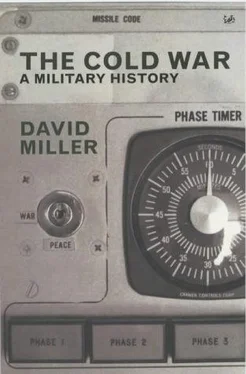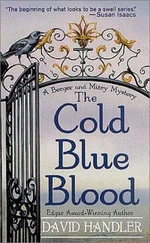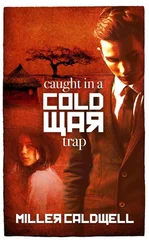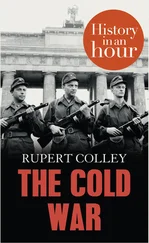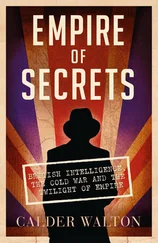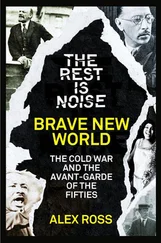Italy: Communist Party in, 8–9; reparations, 9; membership of NATO, 20; joins Brussels Treaty, 26; navy, 170; submarines, 195; aircraft carrier, 205; surface ships allocated to France (1948), 215; battleships, 217; airborne troops, 242; battle tanks, 265n, 266n; aircraft, 308–9; battlefield nuclear weapons in, 350; artillery, 437
Japan: war with Russia (1904–5), 175n; carrier-borne air attacks on (1942), 199n; see also Hiroshima; Nagasaki; Tokyo
Jaruzelski, General Wojciech, 29, 63–4
Jaujard, Vice-Admiral Robert, 12, 392
JIGSAW studies on effects of nuclear warfare, 368–70, 372–3, 375
Johnson Island (Pacific), 76n
Johnson, Lyndon B.: visits Berlin, 342
jungle: effects of nuclear weapons in, 363n
Jupiter missile, 96
Kádár, János, 58
Kahn, Herman, 383
Kania, Stanisław, 63
Karelia, 9
Katyn Forest massacre (1940), 62
Kennedy, John F.: assassination, 27; in Berlin, 27; proposes Multi-Lateral Force, 116; cancels Skybolt, 131; and Berlin crisis, 342; and battlefield nuclear weapons, 355
Khrushchev, Nikita: and US spy-plane incident, 27; fall (1964), 27; de-Stalinization, 57, 65; and Polish unrest, 62; Hoxha resists, 65; cuts surface fleet, 212; proposes West Berlin as ‘Free City’, 340
Konev, General Ivan S., 343
Korea: Communists in, 10
Korean War (1950–3): outbreak, 25, 47, 267; aircraft carriers in, 197; minefields, 220; amphibious landings, 223; massed Chinese infantry in, 257n; tank warfare in, 258, 267; aircraft in, 303; missiles in, 352
Krenz, Egon, 345
Kroger spy ring, 178
Kulikov, Marshal V. G., 63
Kuznetzov, Admiral N. M., 177
landing craft see amphibious warfare
Lange, Halvard, 14
Lattre de Tassigny, General Jean de, 12–13, 392
Latvia: independence (1991), 67
Lebanon: US Marines in, 225
Lemnitzer, Major-General Lyman L., 12, 39
Lend-Lease agreement, 16
Levi, Barbara G. (and others): ‘Civilian Casualties from “Limited” Nuclear Attacks on the USSR’, 442n
Libya: US air strikes on, 210
Linebacker II, Operation, 135
Lithuania: independence (1990), 67
London: World War II missile attacks on, 82, 83
Long Island (US fleet escort), 209
Luxembourg: in Benelux, 10–11; in Brussels Treaty, 11; army, 234; air force, 299
Maclean, Donald, 18n
McNamara, Robert, 365
Malaya: ‘emergency’ in, 9–10
Maniu, Iuliu, 8
Manoeuvrable Re-entry Vehicle (MaRV), 92
marines see amphibious warfare
Marras, General Efisio, 20
Marshall, General George: and Nordic pact, 15; and European defence system, 17–18; retires, 19
Marshall Plan: 1947 Conference (Paris), 7; France opposes, 8
Masaryk, Jan, 7
Mediterranean: and NATO command structure, 47, 49, 51; NATO navies in, 168, 170; Soviet fleet in, 178–9; aircraft carriers in, 198
Michael, King of Romania, 65
Midway (US carrier), 111
Mikołajczyk, Stanislaw, 7
Mikoyan, Anastas, 58
Mildenhall, Suffolk, England, 300
mine warfare and minesweepers: in NATO, 219–22; World War II numbers and damage, 432
Minuteman missile, 97–8, 106, 108–9
Missile, Experimental (MX) programme (USA), 98
missiles see ballistic missiles; cruise missiles
Mitterrand, François: supports French nuclear weapons, 36; and use of tactical nuclear weapons, 357; and reduction of nuclear forces, 384
Moldova: independence (1991), 67
Moltke, Helmuth von, the younger, 326
Mönchengladbach, 238, 297
Montgomery, Field Marshal Bernard Law, 12–13, 47, 392
Moscow: as ‘withhold’, 87n, 90; as target, 364
Mountbatten, Admiral Louis, 1st Earl, 49–50
Multi-Lateral Force (MLF), 116–17
Multi-Role Combat Aircraft (MRCA), 307, 309–10
multiple independently-targeted re-entry vehicles (MIRVs), 92, 98, 101, 112, 119, 141
Multiple Protective Structures (MPSs), 106–7
multiple re-entry vehicles (MRVs), 92, 140–1
Multiple Rocket-Launcher System, 247
Munich Agreement (1938), 59, 61
Mutual and Balanced Force Reductions (MBFR), 28–30
Mutual Defense Assistance Program (MDAP), 195, 216, 221, 270
Mutually Assured Destruction policy (MAD), 365
Nagasaki, 72, 75, 80–1, 124, 136, 363, 373–4
Nagy, Imre, 57
Nautilus (US submarine), 185
Navaho cruise missile, 95–6
navies: and command of sea, 163; NATO, 163–73, 425; forces and commands, 172–3; Warsaw Pact, 174–83, 425; surface ships, 208–18; see also aircraft carriers; battleships; mine warfare and minesweepers; submarines
Netherlands: in Benelux, 10–11; in Brussels Treaty, 11; navy, 170; aircraft carrier, 205; commando group, 227; army, 234; mobilization, 244; logistical problems, 246; and refugee problem, 246; deployment of forces, 248; armoured infantry fighting vehicles, 277, 279; air force and aircraft, 299, 308–9; battlefield nuclear weapons in, 350
neutron bomb see enhanced-radiation warhead
Nicholson, Major Arthur, 344
Nixon, Richard, 135
Nordic pact, 13–15
Norstadt, General Lauris, 338
North Atlantic Assembly, 31
North Atlantic Council: early meetings, 25; and NATO recommendations, 32; France and, 35; on Hungarian uprising, 37; and Czech crisis (1968), 39
North Atlantic Treaty: agreed, 10, 13, 18; signed (1949), 22; text, 394–7
North Atlantic Treaty Organization (NATO): formation and membership, 17–24, 31–2; military strength, 22; forward-defence policy, 25, 237; organization and structure, 25, 31–2, 45–53, 296–8; ‘Athens Guidelines’ (on use of nuclear weapons), 27; France withdraws from command structure, 27, 33–6, 50, 168, 236; moves HQs from France, 27, 34–5; strategic policy, 27–8; publishes reports on balance of power, 29; consultations and procedures, 31–2; and end of Cold War, 31; Defence College, Rome, 35; and Hungarian rising, 37; and Czech crisis (1968), 38–40; and Soviet SS-20 missile deployment, 40–3; long-range tactical nuclear force (LRTNF), 42; aims, 45; US influence in, 45–6; commands, 46–51, 238–40, 296–8; regional planning groups, 46; telecommunications systems, 51–3; and formation of Warsaw Pact, 54–5; non-intervention in eastern Europe, 66–7; control of MLF, 117; civil defence, 153–4; navies, 163–73, 425; mine warfare (1950s), 219–22; European land forces (Central Region), 231–5; European defence strategy and forces, 237–49, 358–9, 375–6; and ‘flexible response’, 237, 365; airborne forces, 241–3; mobilization, 243–6, 323, 325, 327; logistics and communications, 246–8; Refugee Agency, 246; deployment of forces, 248; battle tanks, 265–72, 435; field artillery, 283; air forces, 295–301; Airborne Early Warning Force (NAEWF), 296; equipment standardization, 295; fighter and attack aircraft, 302–11; as defensive alliance, 319; warning and alert systems against surprise attacks, 319–25; battlefield nuclear weapons (tactical), 349–55, 357, 383–5; financing, 379; appointments and office holders, 402–4; mine countermeasures programme, 433–4
Northern Group of Forces (Soviet; NFG), 252–3
Norway: and Nordic pact, 13–15; Soviet threat to, 17–18; membership of NATO, 19–21; civil defence, 153; sea supplies to, 163; navy, 170–1; and Soviet fleet activities, 178–80; submarines, 195; US Marine Corps reinforces, 225; aircraft, 308–9
Novorossiysk (Soviet battleship), 177, 217
nuclear war: pre-emptive attacks, 78–9; effects, 362–78, 387, 441–2; fear of, 383–4, 387; speculations on outbreak of, 385–7
nuclear weapons: NATO use of, 27; Catholic Church on, 36 & n; tactical battlefield (guns and missiles), 42, 86, 348–57, 383–4, 386, 438–40; and Warsaw Pact, 57; effects of explosions, 71–82, 367–8; testing and first uses, 80–2, 405; deterrent effect, 84–6, 387; strategy and planning, 84–8; types of attack and targets, 88–91, 354–5, 364, 366–7; in UK, 136–41; in France, 141–4; in China, 144–8; balance and measurement of, 155–60; availability, 156–7; reliability, 157–8; aircraft-carrier-borne, 199–200; safety measures, 355; use and effect of, 355–7; in Warsaw Pact attack plans, 362; voluntary destruction of, 384
Читать дальше
